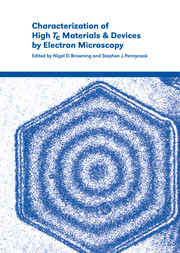Book contents
- Frontmatter
- Contents
- List of contributors
- Preface
- 1 High-resolution transmission electron microscopy
- 2 Holography in the transmission electron microscope
- 3 Microanalysis by scanning transmission electron microscopy
- 4 Specimen preparation for transmission electron microscopy
- 5 Low-temperature scanning electron microscopy
- 6 Scanning tunneling microscopy
- 7 Identification of new superconducting compounds by electron microscopy
- 8 Valence band electron energy loss spectroscopy (EELS) of oxide superconductors
- 9 Investigation of charge distribution in Bi2Sr2CaCu2O8 and YBa2Cu3O7
- 10 Grain boundaries in high Tc materials: transport properties and structure
- 11 The atomic structure and carrier concentration at grain boundaries in YBa2Cu3O7–δ
- 12 Microstructures in superconducting YBa2Cu3O7 thin films
- 13 Investigations on the microstructure of YBa2Cu3O7 thin-film edge Josephson junctions by high-resolution electron microscopy
- 14 Controlling the structure and properties of high Tc thin-film devices
14 - Controlling the structure and properties of high Tc thin-film devices
Published online by Cambridge University Press: 21 August 2009
- Frontmatter
- Contents
- List of contributors
- Preface
- 1 High-resolution transmission electron microscopy
- 2 Holography in the transmission electron microscope
- 3 Microanalysis by scanning transmission electron microscopy
- 4 Specimen preparation for transmission electron microscopy
- 5 Low-temperature scanning electron microscopy
- 6 Scanning tunneling microscopy
- 7 Identification of new superconducting compounds by electron microscopy
- 8 Valence band electron energy loss spectroscopy (EELS) of oxide superconductors
- 9 Investigation of charge distribution in Bi2Sr2CaCu2O8 and YBa2Cu3O7
- 10 Grain boundaries in high Tc materials: transport properties and structure
- 11 The atomic structure and carrier concentration at grain boundaries in YBa2Cu3O7–δ
- 12 Microstructures in superconducting YBa2Cu3O7 thin films
- 13 Investigations on the microstructure of YBa2Cu3O7 thin-film edge Josephson junctions by high-resolution electron microscopy
- 14 Controlling the structure and properties of high Tc thin-film devices
Summary
Introduction
The highly anisotropic crystal structures of the layered high Tc superconducting cuprates induce the necessity of using epitaxial films in most devices based on high Tc thin films. Each individual application demands a specific crystallographic orientation of the film as well as a certain combination of substrate, high Tc superconducting film and non-superconducting layer materials. The intention of this chapter is to provide examples of what aspects need to be considered when designing the device and predicting its behavior. The behavior depends on the detailed microstructure of the thin films. The examples are therefore discussed in terms of microstructure and how it can be controlled and manipulated.
As in all epitaxial structures, the interfacial interactions are crucial for the resulting microstructures. The direct interaction between the substrate and a single-layer high Tc thin film is illustrated in the following section. The description is followed by a discussion of different aspects of the use of buffer layers. The text is restricted to high Tc YBa2Cu3O7–x (YBCO), mainly owing to the fact that the vast majority of published data concern this superconductor. However, there are common characteristics of epitaxial film growth between different high Tc superconductors. Results from the YBCO films can thus be used when considering the other high Tc superconducting thin films which is pointed out in Section 14.10.
The mechanical interaction between the different epitaxial layers may result in the formation of misfit dislocations. Nucleation and propagation of cracks can ensue if the mismatch in thermal expansion coefficient is relatively large.
- Type
- Chapter
- Information
- Publisher: Cambridge University PressPrint publication year: 2000

